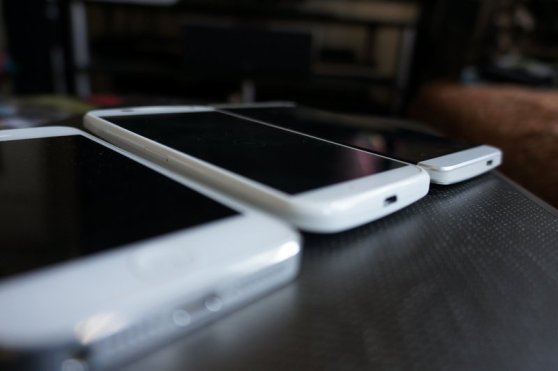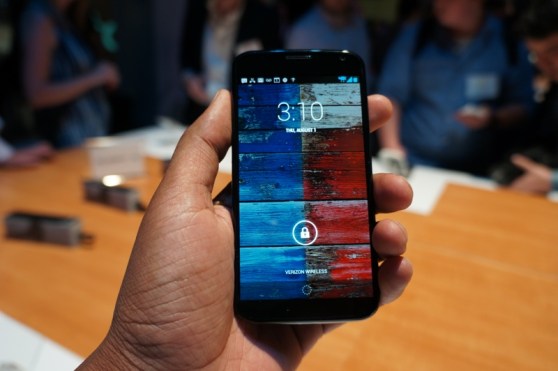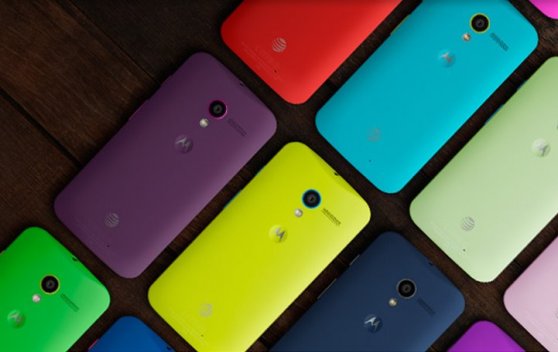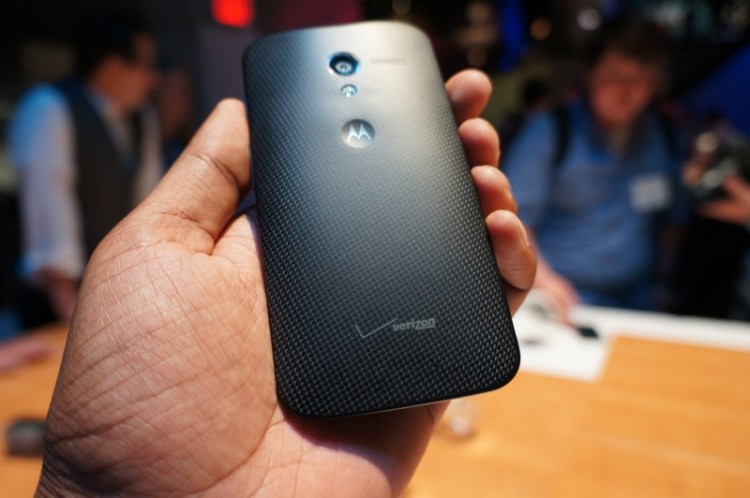The Moto X proves you can still make a great phone even if it’s not the fastest one around.
It offers the most comfortable Android phone experience I’ve seen yet, with hardware that shows iPhone levels of obsession and features that you can’t find anywhere else. And it’s readily accessible for just about anyone, even though it still manages to be plenty innovative.
Motorola has delivered a flagship Android smartphone with selling points beyond the size of its screen or the speed of its processor. That may not sound very exciting, but it’s an important shift in the smartphone market. We’ve reached a point where even midrange hardware is “good enough” for the average consumer, so perhaps it’s more worthwhile for phone makers to spend time differentiating themselves in other ways.
Perhaps the most important thing about the Moto X is how it completely moves the conversation away from mere specs and toward how we actually use our devices.
It’s something new that other Android manufacturers haven’t been able to do: Samsung has been dead-set on making as many Android phones is it can and packing in ever-bigger screens and faster hardware. HTC and others have been doing pretty much the same (though HTC has exhibited some impressive restraint with its recent One smartphone).
As the first major smartphone developed by Motorola as a Google subsidiary (after Google spent $12.5 billion on it last year), Moto X undoubtedly has a lot to prove. But surprisingly, most of my expectations simply melted away after a few days of using the phone.
The good: Developed with care — and it shows
With the Moto X, Google finally had a chance to construct an Android phone with full control of both the hardware and software. Basically, it’s a chance to mimic one of the major advantages Apple has had with the iPhone.
Android’s biggest problem so far is that as a free platform, just about any company can make their own Android phone. That’s a big draw for device makers, but it makes it hard for Google to guarantee quality products on its platform. Aside from a few standouts like Samsung’s Galaxy S series, HTC’s One, and the lineup of Nexus devices, most Android phones don’t hold a candle to Apple’s obsessive iPhone design.
But with the Moto X, it’s almost as if Motorola has taken obsessive hardware and software design to the next level.

Above: From left to right: iPhone 5, Moto X, and HTC One.
The phone features a curved back that feels made for the contours of your hand, and it has a reassuring heft (unlike so many Samsung devices and other cheap-feeling phones). The Moto X’s front is made of standard plastic, while the rear is made of a unique composite material that feels smooth yet strong. Motorola has plenty of experience working with Kevlar in its most recent Droid devices, but the company hasn’t confirmed if it’s using Kevlar in the Moto X.
The Moto X may look unassuming from afar, but it’ll wow you the moment you pick it up. It packs in a 4.7-inch screen like the HTC One, but Motorola worked hard to edge out as much screen extraneous bezel as it could. Ultimately, that means the Moto X feels like a much smaller phone than the HTC One without sacrificing screen size.
In your hand, the Moto X feels comfortable yet solidly built. The plastic case has no flex (something that’s been all too common in Samsung’s phones), and while it isn’t the lightest smartphone out there, I actually appreciated its substantial feel.
The phone is also notable for being the first smartphone built in the U.S. I don’t know if that will have much of an impact on consumers, but it’s nice to see companies at least attempting to bring device manufacturing back to the U.S. (even though it likely makes the entire process more expensive).
Motorola is also aiming to make the Moto X the most customizable smartphone on the market (also something made possible by its U.S. manufacturing). Buyers will be able to customize their Moto X’s front and rear covers and even the colors of its buttons, all through Motorola’s website. I didn’t have a chance to test out the customization options, but Motorola claims that you’ll be able to customize the phone in more than 2,000 ways. Wood back panels would also be available later this year.
Under the hood, the Moto X offers an almost entirely pure Android 4.2 experience. What little Motorola changed was for the better. The Moto X’s minimalist camera interface, for example, is miles beyond Android’s clunky stock camera app.

Bringing sanity back to specs
I’ve never seen the point of 1080p displays on smartphone screens, and it seems like Motorola agrees. The Moto X sports a lower-resolution 720p display. But given its screen size, it sports a pixel density of more than 300 pixels per inch. That means it’s virtually impossible to make out individual pixels on the screen, which makes it practically indistinguishable from 1080p displays. The phone’s OLED screen is bright and clear, though colors seemed slightly oversaturated (typical for many OLED displays).
Without the unnecessary 1080p display, Motorola didn’t have to worry as much about including the fastest possible processors (which are typically necessary to power games and other demanding apps on high-resolution displays).
The Moto X is powered by a dual-core Snapdragon processor, which is assisted by additional processor cores dedicated to the phone’s always-on voice commands and contextual awareness.
All of the processing cores in the Moto X, which includes four graphics cores, makes up Motorola’s X8 Mobile Computing System. Even though it’s sometimes referred to as an “eight core” processor, that’s not technically accurate, since only two of the cores are dedicated to general processing work. Still, the X8 system, which is also found in the latest Motorola Droids, is notable for how it efficiently distributes computing power across the device. Without X8, Motorola wouldn’t be able to implement many of the Moto X’s features (more on those below).
The Moto X handled everything I threw at it, from juggling intensive apps to playing complex games. Only the most serious gadget fan would notice that it isn’t technically as fast as competing devices sporting more powerful processors, like Qualcomm’s S600 and S800 chips.
Motorola claims the Moto X gets around 24 hours of battery life, which is an unfortunate bit of spec bravado in an otherwise sensible product. No, the phone doesn’t run for 24 hours straight — but it does seem to last longer than other popular Android phones. While the HTC One and Samsung Galaxy S4 would barely last me a full day, the Moto X often had juice to spare by the end of the day (and still kept a decent amount of charge overnight).
Ultimately, Moto X owners will be far too busy actually using the phone instead of running system benchmarks to compare it to other phones.
Unique features you’ll actually use
I didn’t expect it going into this review, but the Moto X has spoiled me for any other smartphone that doesn’t feature always-on voice commands. Simply saying “OK, Google Now” — even while the phone is locked and out of reach — invokes Google’s Android virtual assistant, letting you do things like dictate a text, initiate a call, or even get directions.
Google Now is a big selling point for other modern Android phones, but being able to tap into it at will felt on the Moto X was a revelation. It’s sort of like having the power of Google Glass without the dorky eyewear. (Google recently added the feature to its iOS search apps, but it’s not nearly as well integrated there).
Training the Moto X to recognize your voice is a relatively simple process (you just need to say “Okay Google Now” three times in a quiet room), and I also noticed that its accuracy improved over the past few days. If you have multiple Android devices, Google is actually tracking all of your voice data on its servers to improve its recognition capabilities. That’s a bit terrifying, but, hey, at least it means voice recognition finally works reliably.
You can also enable the Moto X’s camera even while it’s asleep simply by flicking your wrist twice (the motion resembles turning a doorknob). I initially just used the gesture for fun, but over time I noticed that it also encouraged me to take more photos. Even if you don’t end up using the camera flick gesture, Motorola could end up developing more unique gestures to access other aspects of the phone down the line.
That helpful gesture recognition is powered by the Moto X’s dedicated contextual computing core, which enables the phone’s display notifications and other sensor-heavy features like Moto Assist. With Assist enabled, your Moto X can detect when you’re in a moving car and automatically announce calls and read text messages aloud. You can also command the phone to stay silent during meetings and when you’re sleeping.
I grew to love the Moto X’s display notifications: The phone’s display fades in and out as it’s sitting on a flat surface, enabling you to quickly glance at the time or incoming notifications (which you can easily interact with from the notification screen). The Moto X is also smart enough to turn on its display when you take it out of your pocket. Like many smartphone owners, I have the terrible habit of obsessively waking up my phone to check the time and incoming notifications — but the Moto X’s smart display made the completely unnecessary.
None of the Moto X’s features are standouts on their own, but taken as a whole they represent a fundamental change in the way we use our smartphones. You shouldn’t have to manually turn on your phone and issue commands. If your smartphone is truly a smart phone, it should be able to tell automatically when you take it out of your pocket or issuing a voice commands.

Above: An array of Moto X color options.
The bad: Customization options limited at first, camera is merely average
Given how much Motorola is touting the Moto X’s customization options, it’s surprising that it’s only being offered to AT&T customers at first. All of the other major carriers will offer the black and white versions of the phone when it launches. Motorola representatives hinted that the customization options will eventually open up to other carriers, but they weren’t clear how long that will take.
The limited customization availability will likely douse some of the enthusiasm from prospective buyers, and it also harkens back to archaic and confusing carrier-only deals. Google famously tried to avoid playing into carriers hands with its Nexus series of devices. It went as far as to let the Nexus 4 ship without LTE 4G, since including the feature would have involved significant discussions with carriers.
Now, with the Moto X, it seems like Google is working more closely with carriers than it ever has before. That could ultimately help the Moto X’s sales, but it could lead to trouble when waiting for system updates.
Even though Motorola made it dead simple to access the Moto X’s camera, it’s a shame that the camera itself isn’t that great. Its quality was completely unpredictable for both indoor and outdoor shots . Some pictures looked great, while others seemed downright embarrassing for a modern 10 megapixel shooter. At times colors seemed washed out, the camera often had trouble focusing, and anything but perfect lighting led to ugly photos. (On the bright side, I appreciated the phone’s ability to take burst photos simply by holding down your finger anywhere on the screen.)
Check out some sample photos from the Moto X:
For all the major strides we’ve been making in smartphone cameras over the years — most notably, the monster 41 megapixel shooter in the Lumia 1020 Windows Phone — not much of that progress is evident in the Moto X.
Motorola made a big deal about the Moto X’s “Clear Pixel” camera during the phone’s announcement, which allegedly lets in 75 percent more light than typical smartphone cameras. For the most part though, I didn’t notice anything special about how it handled light.
I’m also slightly disappointed Motorola went with the typical $200 (with a two-year contract) pricing for the Moto X. If Google and Motorola truly wanted to make a splash, not to mention strike fear into the hearts of Apple and Microsoft, they should have tried for a bolder $100 contracted price. That would have involved heavily subsidizing the cost of the phone — something that was likely unfeasible when you also account for Motorola’s terrible earnings over the past few years.
Motorola mentioned it’s working on a cheaper version of the Moto X, and we can imagine that an even more high-end offering is coming.

The verdict: Motorola proves it can still innovate
A year ago, I never would have guessed that I’d be praising a Motorola phone today. The company’s last few Droid updates have been fairly uninspiring, aside from Motorola’s recent focus on long battery life. The Moto X proves that Motorola can once again create exciting new products with features that we’ve never seen before.
Is that enough for me to recommend the Moto X? I still find the HTC One to be the best choice on Android for me, but I can’t imagine anyone being disappointed by the Moto X. Now, Android buyers have more to choose from than just the Galaxy S4 and HTC One, which is ultimately good for both consumers and the Android ecosystem.
The real question for Motorola and Google: Will it be able to make consumer pay attention to Moto X amid today’s crowded smartphone market? Google will reportedly spend up to $500 million marketing the phone, but with a new iPhone on the horizon and HTC prepping a $1 billion ad campaign starring Robert Downey Jr., it’s going to be tough to make an impact.
Photos: Devindra Hardawar/VentureBeat, unless otherwise noted.

















